#artiodactyl antelope
Explore tagged Tumblr posts
Text

I had never seen one of the grazing animals come up so close to the walkways before this. Certainly seemed interested in my french fries!
* Friendly reminder not to feed the animals at ANY zoo or amusement park!
#not roller coasters#nyala#wild animals#zoo animals#animals#animal#artiodactyl antelope#zoology#busch gardens#busch gardens tampa bay#busch gardens tampa#busch gardens florida#busch gardens fl#tampa bay florida#tampa bay fl#tampa bay#tampa fl#fl#florida#central florida#photography#my photography#theme park photography#theme park#amusement park#amusement parks#2023#july 2023
172 notes
·
View notes
Text
Round 3 - Mammalia - Artiodactyla

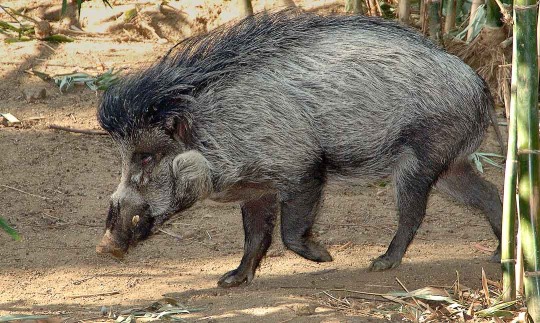


(Sources - 1, 2, 3, 4)
Our final order of mammals, and second order of ungulates is Artiodactyla, commonly referred to as “even-toed ungulates”. Artiodactyla is a large and highly diverse group which includes the living families Camelidae (“camels”, “vicuñas”, “guanacos”, and kin), Suidae (“pigs”), Tayassuidae (“peccaries”), Hippopotamidae (“hippopotamuses”), Balaenidae (“right whales” and “Bowhead Whale”), Cetotheriidae (“Pygmy Right Whale”), Balaenopteridae (“rorquals”), Eschrichtiidae (“Gray Whale”), Delphinidae (“oceanic dolphins”), Monodontidae (“Beluga Whale” and “Narwhal”), Phocoenidae (“porpoises”), Kogiidae (“Pygmy and Dwarf Sperm Whales”), Physeteridae (“Sperm Whale”), Iniidae (“South American river dolphins”), Platanistidae (“south Asian river dolphins”), Pontoporiidae (“La Plata Dolphin”), Ziphiidae (“beaked whales”), Tragulidae (“chevrotains”), Antilocapridae (“Pronghorn”), Giraffidae (“giraffes” and “Okapi”), Cervidae (“deer”), Moschidae (“musk deer”), and Bovidae (“cattle”, “antelopes”, “goats”, and kin).
Artiodactyls are typically defined by the fact that they bear most of their weight equally on two or four of the five original ungulate toes. However, all living members of the infraorder Cetacea have lost their toes, replacing them with flipper-like limbs. Many artiodactyls have a relatively large head, with an elongated and narrow skull. Some families have cranial appendages, which include true horns, antlers, ossicones, or pronghorns. True horns have a bone core that is covered in a permanent sheath of keratin, and are found only in the Bovids. Antlers are bony structures that are shed and replaced each year, only found in deer. Artiodactyls have a well-developed sense of smell and sense of hearing. Similar to many other prey animals, their eyes are on the sides of the head, giving them an almost panoramic view, so that they can keep an eye out for predators while grazing. This order is highly diverse, ranging in size from the rabbit-sized Java Mouse-deer (Tragulus javanicus) to the largest mammal, and possibly the largest animal to ever exist: the Blue Whale (Balaenoptera musculus). Most are herbivorous, but many are omnivores or even carnivores.
Male artiodactyls are usually larger than females. In the majority of deer species, only the males grow antlers, and the horns of female bovines are usually smaller or absent. As this is a very diverse group, social and mating behavior vary between species. They have a tendency to form larger groups, but some live alone or in pairs. Species living in groups often have a hierarchy, both among males and females. Some species also live in harem groups, with one male, several females, and their common offspring. In other species, the females and juveniles stay together, while males are solitary or live in bachelor groups and seek out females only during mating season. Generally, artiodactyls tend to have long gestation periods, smaller litter sizes, and more highly-developed young (usually called a “calf”). Most deliver 1 or 2 calves at a time, but some pigs can deliver up to ten. Newborn artiodactyls are precocial and are born with hair and open eyes.
The oldest fossils of artiodactyls date back to the early Eocene (about 53 million years ago).

Propaganda under the cut:
More than half the species in the family Camelidae are domesticated, with the only living wild camelids being the Vicuña (Lama vicugna) (ancestor of the domestic Alpaca), the Guanaco (Lama guanicoe) (ancestor of the domestic Llama), and the Wild Bactrian Camel (Camelus ferus) (NOT the ancestor of the Domestic Bactrian).
Camelids have true canine teeth and tusk-like premolars, which are separated from the molars by a gap.
Both the Bactrian Camel (Camelus bactrianus) (image 1) and the Dromedary (Camelus dromedarius) were domesticated in ancient times for riding, transport, ploughing, and as a source of milk, meat, wool, and leather. Today, the wild ancestors of both of these species are extinct, and only feral populations of domestic camels remain. The only truly wild camel species left is the Wild Bactrian Camel (Camelus ferus), which is critically endangered.
The Wild Bactrian Camel can survive on water saltier than seawater, something which no other mammal in the world seems to be able to tolerate, including the domestic Bactrian Camel.
In Aymara mythology, Llamas (Lama glama) are sacred beings. The Heavenly Llama is said to drink water from the ocean and urinates as it rains. According to Aymara eschatology, llamas will return to the water springs and ponds where they come from at the end of time.
Babirusas (genus Babyrousa) are unique for their prominent, upwards incurving, canine tusks, which pierce out through the flesh of the snout in males. The upper canine tusks continue growing, curving backward over the front of the face and towards the forehead. If a male Babirusa does not grind his tusks (achievable through regular activity), they can eventually keep growing and, rarely, even penetrate the individual's skull.
The Domestic Pig (Sus domesticus) was domesticated from the Wild Boar (Sus scrofa) beginning in the Neolithic, and is a result of two different domestication events in both the Middle East and China. They are mostly kept for meat and leather, but are also used in medicine and as pets. The Domestic Pig is one of the few omnivorous animals to be domesticated.
The endangered Chacoan Peccary (Catagonus wagneri) is the rarest of the 3 living species of peccary, with only around 3,000 individuals left in the world. It is a “Lazarus taxon”, as its genus was first described from fossil remains of the extinct Catagonus metropolitanus. The Chacoan Peccary only lives in hot, dry, thorny areas of the Gran Chaco.
While the semi-aquatic hippopotamuses were once more diverse, only two species of different branching lineages remain: the vulnerable Common Hippopotamus (Hippopotamus amphibius) (see gif above) and the endangered Pygmy Hippopotamus (Choeropsis liberiensis).
The Egyptian goddess Tawaret is depicted as a pregnant woman with a hippopotamus head, representing fierce maternal love.
Humans have hunted whales since prehistoric times, with depictions of whaling dating back to 6000 BC. Whales are hunted for their meat, blubber, and oil. Whale oil was in high demand for lighting lamps in the 18th century. The Sperm Whale (Physeter macrocephalus) was particularly prized for spermaceti, a dense waxy substance that burns with an exceedingly bright flame that is found in the whale’s spermaceti organ. Approximately 40% of Right Whales' (genus Eubalaena) (image 3) body mass is blubber, and thus they were known as the "right" whale to kill. Today, the North Atlantic Right Whale (Eubalaena glacialis) is the most critically endangered great whale, with around 372 individuals left in the world. While whale hunting has been significantly curtailed in recent years, whales still face threats from entanglement in fishing gear, boat strikes, underwater noise pollution, plastic and heavy metals build-up, and accelerating climate change. Cetaceans are still hunted in some countries.
The Humpback Whale (Megaptera novaeangliae) is known to not only fight back against their main predators, Orcas (Orcinus orca), but also to interfere with Orca hunting parties, rescuing their prey.
The mysterious Narwhal (Monodon monoceros) is known for the long tusk of the males, which is a protruding left canine thought to function as a weapon, a tool for feeding, in attracting mates, or for sensing water salinity. Some males may grow two tusks, occurring when the right canine also protrudes through the lip. Some females may grow a tusk as well, but it is usually smaller than the tusks of males.
The critically endangered Vaquita (Phocoena sinus) is the smallest of all living cetaceans, reaching a maximum body length of 150 cm (4.9 ft) for females or 140 cm (4.6 ft) for males. The Vaquita is one of the most endangered animals in the world, with around 6-11 individuals remaining. They are endangered primarily due to bycatch in gillnets from the illegal Totoaba (Totoaba macdonaldi) fishery.
The Baiji (Lipotes vexillifer) was a river dolphin, and the last surviving member of the family Lipotidae. It is classified as "critically endangered: possibly extinct", as no specimens have been seen in the Yangtze River in over 20 years. Heavy use of the river for fishing, transportation, and hydroelectricity were the likely causes of this unique species’ extinction. While some individuals may survive, their population is likely too low to recover. If indeed extinct, the Baiji's disappearance would be the first recorded extinction of a well-studied cetacean species to be directly attributable to human influence.
The Pronghorn (Antilocapra americana) is the last surviving member of its family. While they are sometimes referred to as antelope, this is an example of convergent evolution, and their closest living relatives are the Giraffids. The Pronghorn is the fastest land mammal in the Americas, and the third fastest land mammal on Earth, with running speeds of up to 88.5 km/h (55 mph). This running speed was likely an adaptation to flee the Pleistocene American Cheetahs (genus Miracinonyx), which are now extinct.
Giraffes are the tallest living land animals, with the largest being the Masai Giraffe (Giraffa tippelskirchi). Bull Masai Giraffes can grow up to 5.5 meters (18 feet) in height, and weigh 1,300 kilograms (2,900 pounds).
Caribou (Rangifer tarandus), also known as Reindeer, are unique among Cervids in that females may have antlers, although the prevalence of antlered females varies by subspecies.
Cervid antlers are a controlled form of bone cancer. Antler growth is tightly regulated by the activity of tumor-suppressing and tumor-growth-inhibiting genes. The cancer-suppressing genes that keep growth in check also protect against cancer in general, and documented cancer rates in deer that are five times lower than rates in other mammals.
Musk Deer (genus Moschus) are not true deer belonging to the family Cervidae, but rather their family is most closely related to Bovidae. They are known for the enlarged upper canines, forming sabre-like tusks, grown by the males for display.
The family Bovidae is the largest of the artiodactyls, and ungulates in general, accounting for nearly 55% of the ungulates. They also contain the majority of domesticated animals.
The critically endangered Saola (Pseudoryx nghetinhensis) is also known as the “Asian Unicorn” due to its rarity. The first photograph of a living Saola was taken in captivity in 1993. The most recent one was taken in 2013 by a movement-triggered camera in the forest of central Vietnam.
The African Buffalo (Syncerus caffer), specifically the Syncerus caffer caffer subspecies, the Cape Buffalo, is known as one of the most dangerous animals in Africa. With nicknames like "the Black Death" or "the widowmaker", Cape Buffalos can be highly territorial and defensive, and wounded animals are reported to ambush and attack hunters. (However, Elephants, Nile Crocodiles, and Hippos are still responsible for more deaths per year than African Buffalos are. Not to mention mosquitoes and venomous snakes.)
Domestic Cattle (Bos taurus) and Zebu (Bos indicus) were both domesticated from the now extinct Aurochs (Bos primigenius) during the Neolithic revolution. While the Aurochs is now extinct, Domestic Cattle are the most successful members of their lineage, with over 1.4 billion cattle in the world.
The Springbok (Antidorcas marsupialis) is the fourth fastest land mammal, clocked at 88 km/h (55 mph). They are primarily known for their pronking behavior: bouts of repeated high leaps of up to 2m (6.7 ft) into the air. In pronking, the Springbok performs multiple leaps into the air in a stiff-legged posture, with the back bowed and the white fur on its rump raised. This behavior displays the fitness of males, both to attract mates and to ward off predators, who won’t waste time chasing a healthy, fit Springbok.
The Domestic Sheep (Ovis aries), domesticated from the Mouflon (Ovis gmelini) between 11,000 and 9000 BC in Mesopotamia, and the Domestic Goat (Capra hircus), domesticated from the Bezoar Ibex (Capra aegagrus aegagrus) around 8000 BC, were domesticated to provide easy access to meat, hides, dung (used for fuel), wool, and milk. It is thought that the birth of agriculture and domestication of livestock is what led to human civilizations, as it was hard to be nomadic with a large herd of animals. Villages popped up around pens of livestock, leading to towns, leading to cities.
#animal polls#round 3#mammalia#aaaah sorry this is late I had to sleep before I could finish it again ;_;
154 notes
·
View notes
Text
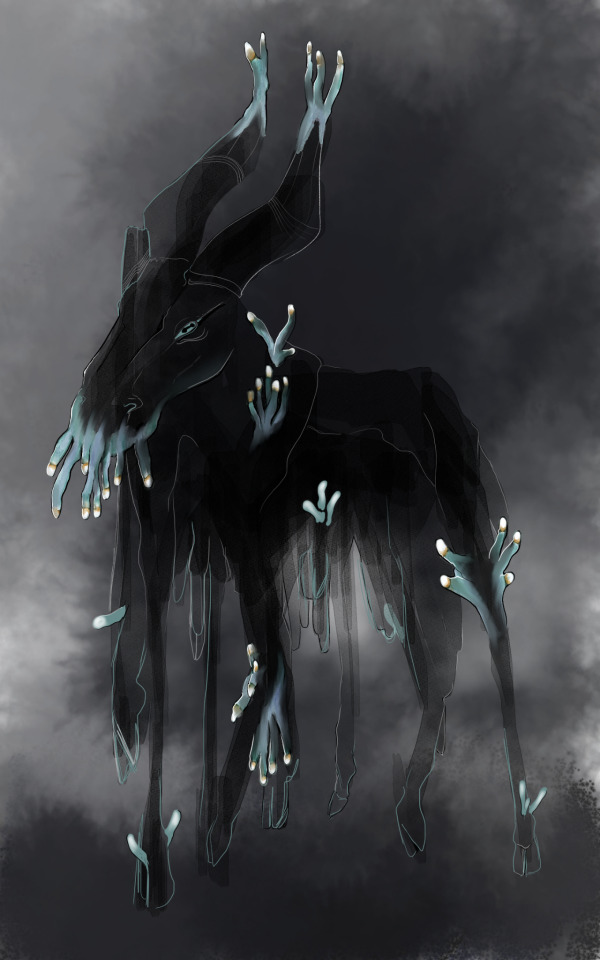
Funguary Feb 12 - Demonic Dead Man's Fingers - Xylaria Polymorpha
Dead man's fingers is a saprobic fungus with geographic distribution across all six inhabited continents. The Dead Man's Deer is a ruminant artiodactyl who's inclusion in the clade is subject to much debate. While the structure of it's feet resemble various antelope subspecies, and the horns most certainly do (they are not antlers), the fact that it has a varying number of legs has perplexed taxonomists for years.
But only those researchers that can outdistance it. While many bovidae will consume meat occasionally, the Dead Man's Deer is unusual in that it is carnivorous in reproduction. It chases and consumes herbivores, adding them gradually to it's organ-less body. Eventually enough portions will be colonised by the blue emanations that they can slough off and create a new Dead Man's Deer.
#funguary#funguary 2024#funguary week 2#funguary 12#original content#dead man's fingers#xylaria polymorpha#dead mans fingers#antelope#deer#cryptid#mushroom#fungus#fungi#original art
18 notes
·
View notes
Text

They also have tusks. They are insanely strange artiodactyls. Yes, whales, dolphins and porpoises are all even-toed ungulates, like cattle, deer, pigs, giraffes, antelopes and hippos. Their closest living relative is the hippo, they are both Whippomorpha.

Look at this male beaked whale with barnacles growing around his tusks.
‘While bats can only sense the outer shapes and textures of their targets, dolphins can peer inside theirs. If a dolphin echolocates on you, it will perceive your lungs and your skeleton. It can likely sense shrapnel in war veterans and fetuses in pregnant women. It can pick out the air-filled swim bladders that allow fish, their main prey, to control their buoyancy.
It can almost certainly tell different species apart based on the shape of those air bladders. And it can tell if a fish has something weird inside it, like a metal hook. In Hawaii, false killer whales often pluck tuna off fishing lines, and “they’ll know where the hook is inside that fish,” Aude Pacini, who studies these animals, tells me. “They can ‘see’ things that you and I would never consider unless we had an X-ray machine or an MRI scanner.”
This penetrating perception is so unusual that scientists have barely begun to consider its implications. The beaked whales, for example, are odontocetes that look dolphin-esque on the outside—but on the inside, their skulls bear a strange assortment of crests, ridges, and bumps, many of which are only found in males.
Pavel Gol’din has suggested that these structures might be the equivalent of deer antlers—showy ornaments that are used to attract mates. Such ornaments would normally protrude from the body in a visible and conspicuous way, but that’s unnecessary for animals that are living medical scanners.’
-Ed Yong, An Immense World
30K notes
·
View notes
Text
Friday mystery object #480 answer
The answer to last week's mystery object includes a mouse that's not a rodent, a label mix-up, an historic misidentification and gratuitous Dik-dik pics. Find out more on the blog:
Last week I gave you this doe-eyed specimen from the collections of the Dead Zoo to try your identification skills out on: I didn’t provide a scalebar as I think it would have made it too easy, but even so, it’s clear that the specimen is a very small species of artiodactyl (the group containing pigs, deer, antelope, bovids and a variety of related herbivores). There were some suggestions that…

View On WordPress
0 notes
Text
Pachycephalosaur domes: Function
Welcome back! We last left our heroine (that’s me!) as she gave a brief overview of the history of interpretations of pachycephalosaur domes. We now return to your regularly scheduled program.
However, little discussion was had of the function of the pachycephalosaur dome in this early work, with suggestions limited to the broad category of “armour” (ex: Gilmore, 1924).
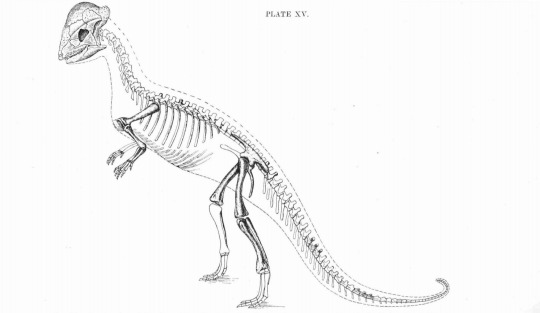
(Image: A skeletal restoration of Stegoceras validum showing pachycephalosaur anatomy as known in 1924. Outlined parts are inferred from comparison with Hypsilophodon. Image from Gilmore (1924).)
The first worker to propose a functional use of pachycephalosaur domes was Edwin Colbert in 1955, who compared the domes to the cranial “bosses” of artiodactyls and suggested that they may have been used similarly in head-butting battles - here used to mean head-to-head smashing contests - over mates.
Galton (1971) thought this was a pretty boss idea, and pointed out that the domes of pachycephalosaurs were made of very thick solid bone. Bone takes a lot of energy to maintain; despite looking like a static, dead rock, it is in fact a living tissue that is constantly remodeling itself (hence why you can repair after a broken bone!). If the domes were just for display, Galton argued that it’d be much more beneficial for them to be hollow. (This would also make them lighter to carry around.)
This still left the suggestion of the dome being used as an anti-predator weapon. Galton argued that this also was unlikely — after all, if something is trying to kill you, why not have a sharply pointed head instead of a dull, rounded one? Finally, Galton pointed out that the neck articulation was rotated to the bottom of the skull, a condition that we’ve seen is extremely rare among animals. He argued that this was an adaptation for transferring stresses away from the brain and into the body after two pachycephalosaurs bonked heads.

(Image: *Bonk*. <Drawings of pachycephalosaur skulls bonking into each other, with arrows showing his interpretation of how forces would be transferred>. From Galton (1971).)
Sues (1978) agreed that the thickening of the skull functioned to reinforce it for use as a battering ram. In order to see whether it had any structures that indicated special adaptations for bonking heads, he cut a pachycephalosaur dome open and looked inside it.
Modern animals that butt heads with each other are, of course, in danger, because the skull contains the brain, which is a part of the body that you generally don’t like getting sloshed around. A completely solid dome, while very durable, might thus not be the best way to go if you’re bonking into things. This is because it would lead to all forces traveling directly into the brain, without absorbing any of the impact. A more springy dome that keeps its strength but can deform would mean that that stress gets reduced. It’s the same reason why modern cars are designed to crumple to keep you safe.
So in order to counter that, modern head-butting mammals have hollow areas on their heads that are reinforced on the inside with bony struts. Here’s an example of that in a Cape Buffalo:
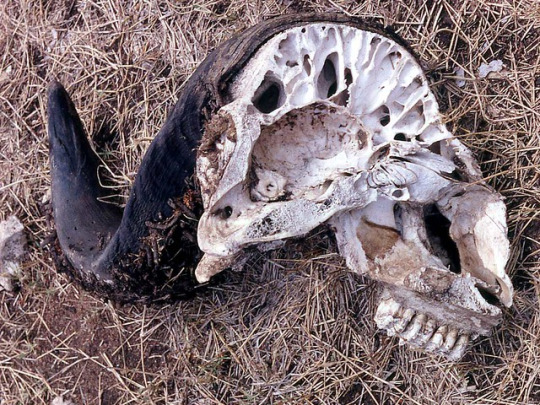
(Photo: The skull of a Cape Buffalo (Syncerus caffer), which has broken open, revealing a complex series of sinuses and body struts under the horns. Source)
So what did Sues find when he cut open the skulls of pachycephalosaurs? See for yourself:
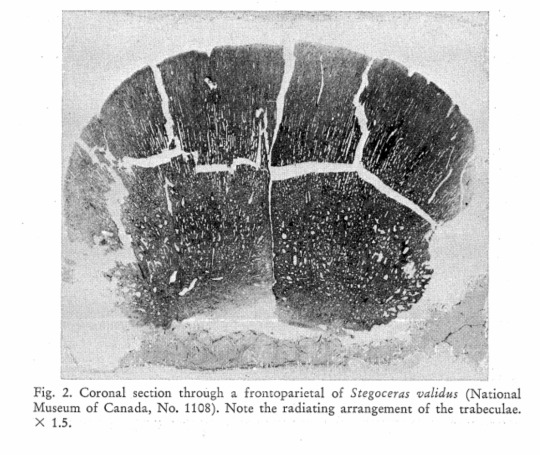
(Image: A thin section through the dome of a Stegoceras validus - this section is cut from “ear to ear”, if that helps you imagine it (though note that their ears weren’t quite in the same place as ours; this is just to help clarify what’s being shown here). I’ll describe anatomically what’s going on in the next paragraph. Image from Sues (1978).)
First things first, those big cracks are not anatomical features; so far as I can tell, they are just cracks in the specimen. What we’re really looking at here are the much smaller bony struts and cavities that radiate away from where the brain would be towards the outside of the skull. Sues termed these radiating trabeculae, and argued that they served a similar function to the sinuses in buffalo. They are not nearly as big as the ones in buffalo, but Sues suggested that differences in brain size and structure might have meant that such protection wasn’t as necessary in pachycephalosaurs.
This idea that the pachycephalosaur skull could resist stresses was elaborated on by Snively and Cox (2008), who, using computer models, demonstrated that point stresses applied to higher-domed skulls would diminish rapidly with distance from the point of contact. They found that flat-headed pachycephalosaur skulls would propagate stresses through their structures far more. Based on these results, they predicted a high occurrence of injury to the surface of the dome.
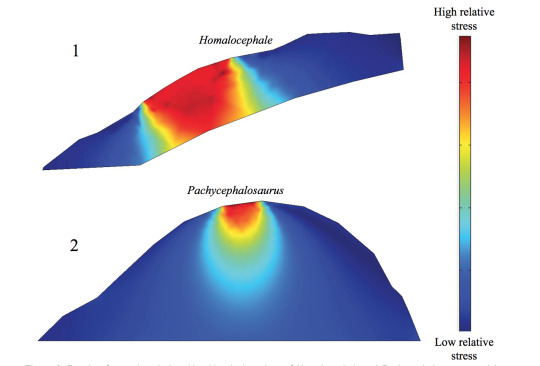
(Image: Biomechanical computer models of the flat-headed Homalocephale and the dome-headed Pachycephalosaurus. The former shows high stresses throughout the “dome”, while the latter shows stresses diminishing near the point of contact.)
Their predictions were confirmed by Peterson et al. (2013), who examined domes across pachycephalosaur diversity for evidence of injury. Fully 22% of specimens observed showed injuries to the frontoparietal dome, and 7% of specimens had 6 or more lesions. This is an insanely high frequency of injury, and lends some support to the idea that they were hitting their heads against something. Injuries were concentrated near the peak of the dome, as might be expected were domes used in butting behaviour; all flat-headed specimens examined lacked head injuries.
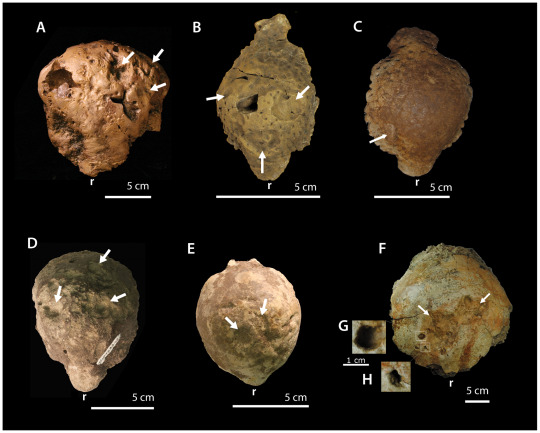
(Image: Six different pachycephalosaur domes, all with surface injuries (indicated with white arrows). Image from Peterson et al (2013).)
Snively and Theodor (2011) offered comparisons to modern head-butting mammals including giraffes, musk oxen, and duikers by examining bone density. Their results showed that pachycephalosaur cranial domes exhibit particularly dense bone superficially but much less dense bone as one moves deeper into the dome, a pattern seen also in head-butting artiodactyls, and suggested that this supports them using their heads to hit things with.
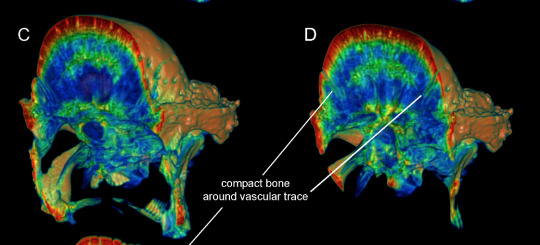
(Image: Scans through the skull of Stegoceras, showing higher bone density in red and lower in blue. Higher-density bone is concentrated towards the outside of the dome, with lower-density bone inside. Modified from Snively and Theodor (2011).)
Modern animals that butt heads typically have broad-flat surfaces (as in bighorn sheep) or otherwise branches or structures to maintain contact (as in ibex, for example). Pachycephalosaurs have neither of these, instead having rounded domes; if two ran at each other, it is easy to image how they might glance off each other and injure their necks. Sues (1978) thus argued that the domed shape might indicate flank-butting (in which animals would ram each others’ sides).
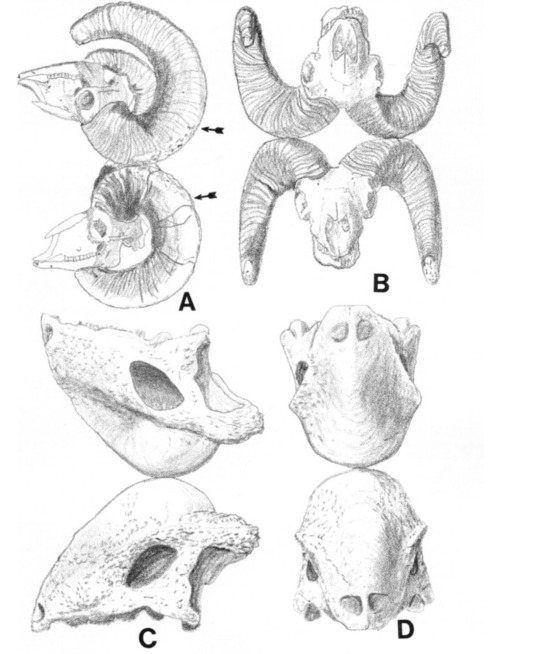
(Image: Problems with pachycephalosaurs bonking heads. Modern bighorn sheep skulls have wide surfaces of contact, while pachycephalosaurs would have only a very small point on the top of a round dome. Image from Carpenter (1997))
This was elaborated upon by Carpenter (1997), who noted that the head-butting hypothesis supposes that the skull and vertebral column act in a straight line to transmit forces through the body (rather than into the neck). Carpenter observed that, though no complete neck is known from a pachycephalosaur, the orientation of the back vertebrae and of the socket on the skull necessitate a gently S-curved neck and back, as in most ornithischians. As such a curved neck would transmit stresses diagonally on the spinal column, it risks breaking the neck. Today’s head-butting mammals solve this problem by having tall spines on their neck and back vertebrae, but these are not present in pachycephalosaurs.
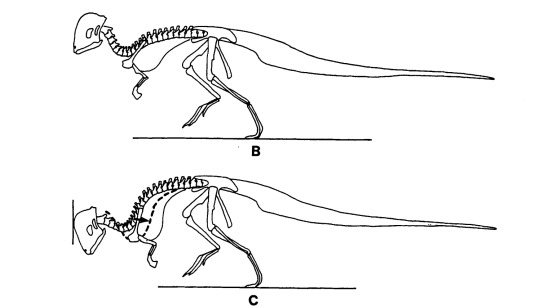
(Image: Schematic drawing of a pachycephalosaur skeleton, showing S-curved neck and transmission of stress shear-wise to vertebral column. Modified from Carpenter (1997).)
He agreed that flank-butting was a more likely use of pachycephalosaur domes, pointing to similar behaviour in modern African antelope. Finally, Carpenter pointed to the wide ribcage of pachycephalosaurs as possible evidence of thickening the torso to better protect against butting behaviour.
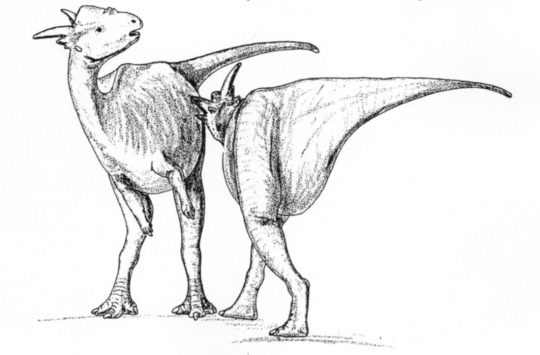
(Image: Drawing of two pachycephalosaurs butting each others’ flanks. Modified from Carpenter (1997).)
Goodwin et al (1998) agreed about flank-butting, and also believed that the structure of the dome would not have offered protection against stresses as the trabeculae were not interconnected. Instead, they interpreted the structures instead as artefacts of rapid growth of the dome.
Bony reinforcements of the tail are pretty common in dinosaurs; they are most extensive in the “duck-billed” hadrosaurs, in which the tendons of the back have turned to bone and effectively make the entire back and tail stiff and unable to move.
Pachycephalosaurs have similar-looking structures on their tails, and Goodwin et al. suggested that the reinforced tail of pachycephalosaurs may have served a role in flank-butting behaviour, offering that it may have been used as a defensive weapon against other pachycephalosaurs.
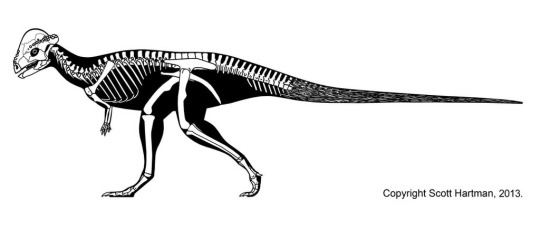
(Image: Skeletal drawing of Stegoceras. Note the complex “basket” of bones reinforcing the tail. Image by Scott Hartman @skeletaldrawing.)
However, the idea of the tail as a defensive weapon was rejected by Brown and Russell (2012). These authors demonstrated that, amazingly, the “basket” of bones reinforcing the tail are not tendons, but instead the divisions between the individual muscle blacks that have turned to bone! This is a condition that’s unknown in any other tetrapod (though it’s present in some fish). Due to the location of the ossifications within the muscles rather than the skin, these authors argued that it would not be useful as a weapon. These authors instead suggested that the the tail served to brace the body in a tripodal stance during flank-butting, an idea first proposed by Maryańska and Osmólska (1974).
The first major objection to be raised against generalised butting behaviour in pachycephalosaurs was by Goodwin and Horner (2004), who sliced into the domes of pachycephalosaur skulls of different ages. Building off of work done by Goodwin et al. (1998), they argued that the “radiating trabeculae” that had been cited by previous authors as being adaptations for reducing strain on the brain are instead temporary features associated with the rapid growth of the skull and disappear as the animal ages, and that the shape of the adult dome was ill-suited for dissipating stress.
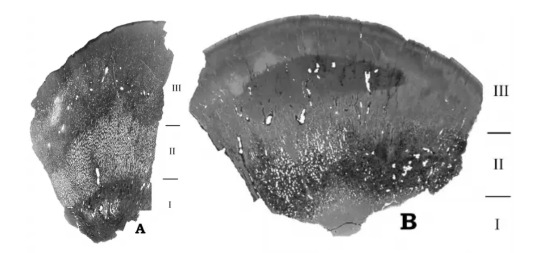
(Image: Thin sections of two pachycephalosaur domes, the left from a younger individual, the right from an older individual. Stage II (the less dense, spongier bone) is propotionally thicker in the younger individual. Images are not to scale. From Goodwin and Horner (2004).)
The authours instead argued that pachycephalosaur domes functioned as species-recognition characteristics, as they were apparently not sexually dimorphic (to be discused in a future post, which will be linked here).
This idea received criticism for failing to address why animals would evolve such thick and dense structures if they were just for display, and I confess I don’t buy the idea at all. . Lehman (2010) also took issue with the characterisation of the dome histology, concluding that the radial structure of the bone was present even in the most superficial, densest bone zone, albeit with a decreased amount of vascularity; and that the less compact, vascular bone was maintained at least until the individual attained adult size. He further noted that trabecular struts of a form similar to those found in pachycephalosaur frontoparietal domes are strongest against compressional stress along their long axis, consistent with high strength in pachycephalosaur domes.
Longrich et al (2010) argued that the dome could not possibly have functioned in species recognition, because dome shape is not significantly different between different species — an observation that, to my view, is an extremely convincing argument against the “species recognition” idea. These authors also pointed out that some degree of asymmetry was not uncommon in pachycephalosaur domes, and noted that this is a common trait of featured which have been sexually selected (both in display structures and intra-specific weapons).
This was a bit of a longer post this week, but I wanted to make sure I had a good overview of different proposed functions of the dome. This series will conclude next week with a look into who had the dome, and finally what I think they were doing with it! A link to that will be >here< once it’s up.
428 notes
·
View notes
Note
Are there any pronouns related to pigs and/or cows?
the only existing ones i could find were related to cows— moo/moo/moos/moos/mooself; if anyone has anymore feel free to comment, but here’s some i made :)
pigs
(i assume you are talking about domestic pigs, if not, send another ask w/ the specific pig u had in mind!)
pig -> pi / pig / pigs / pigs / pigself OR pig / pig / pigs / pigs / pigself
piggy -> pig / gy / (pig)gys / (pig)gys / piggyself OR pi / pig / gys / gys / piggyself OR piggy / piggy / piggys / piggys / piggyself
piglet -> pig / let / (pig)lets / (pig)lets / pigletself OR pi / pig / lets / lets / pigletself OR piglet / piglet / piglets / piglets / pigletself
sus domesticus (trans. ‘domestic pig’, just the scientific name) -> sus / domesticus / (sus)domesticus’ / (sus)domesticus’ / susdomesticusself OR sus / domes / ticus’ / ticus’ / susdomesticusself OR sus / dom / ests / ests / ticusself OR susdomesticus / susdomesticus / susdomesticus’ / susdomesticus’ / susdomesticusself
suidae (“suidae is a family of artiodactyl mammals which are commonly called pigs, hogs or boars.”) -> sui / dae / (sui)daes / (sui)daes / suidaeself OR su / sui / daes / daes / suidaeself OR suidae / suidae / suidaes / suidaes / suidaeself
swine -> swi / ine / (sw)ines / (sw)ines / swineself OR swi / swine / swines / swines / swineself OR swine / swine / swines / swines / swineself
hog -> ho / hog / hogs / hogs / hogself OR hog / hog / hogs / hogs / hogself
oink -> oi / oink / oinks / oinks / oinkself OR oink / oink / oinks / oinks / oink
cows
cow -> co / cow / cows / cows / cowself OR cow / cow / cows / cows / cowself
calf -> ca / calf / calfs / calfs / calfself OR calf / calf / calfs / calfs / calfself
cattle -> cat / tle / (cat)tles / (cat)tles / cattleself OR ca / cat / tles / tles / cattleself OR cattle / cattle / cattles / cattles / cattleself
bos (“bos is the genus of wild and domestic cattle.”) -> bo / bos / bos’ / bos’ / bosself OR bos / bos / bos’ / bos’ / bosself
bovinae (“the biological subfamily Bovinae includes a diverse group of 10 genera of medium to large-sized ungulates, including domestic cattle, bison, African buffalo, the water buffalo, and the four-horned and spiral-horned antelopes.”) -> bov / inae / (bov)inaes / (bov)inaes / bovinaeself OR bov / bovin / aes / aes / bovinaeself OR bo / bov / inaes / inaes / bovinaeself OR bo / bov / ins / ins / aesself OR bovinae / bovinae / bovinaes / bovinaes / bovinaeself
udder -> ud / der / (ud)ders / (ud)ders / udderself OR u / ud / ders / ders / udderself OR udder / udder / udders / udders / udderself
(moo -> moo / moo / moos / moos / mooself)
other related terms
livestock -> live / stock / (live)stocks / (live)stocks / livestockself OR li / live / stocks / stocks / livestockself OR livestock / livestock / livestocks / livestocks / livestockself
barn -> ba / barn / barns / barns / barnself OR barn / barn / barns / barns / barnself
farmyard -> farm / yard / (farm)yards / (farm)yards / farmyardself OR fa / farm / yards / yards / farmyardself OR farmyard / farmyard / farmyards / farmyards / farmyardself
farm -> fa / farm / farms / farms / farmself OR farm / farm / farms / farms / farmself
ranch -> ra / ranch / ranch(e)s / ranch(e)s / ranchself OR ranch / ranch / ranch(e)s / ranch(e)s / ranchself
pasture -> pas / ture / (pas)tures / (pas)tures / pastureself OR pa / pas / tures / tures / pastureself OR pasture / pasture / pastures / pastures / pastureself

4 notes
·
View notes
Photo










pronghorn (Antilocapra americana)
The pronghorn (Antilocapra americana) is a species of artiodactyl mammal indigenous to interior western and central North America. Though not an antelope, it is often known colloquially in North America as the American antelope, prong buck, pronghorn antelope, prairie antelope, or simply antelope[4] because it closely resembles the true antelopes of the Old World and fills a similar ecological niche due to parallel evolution.[5]
It is the only surviving member of the family Antilocapridae.[6] During the Pleistocene epoch, about 12 antilocaprid species existed in North America.[7] Three other genera (Capromeryx,[8][9] Stockoceros[10][11] and Tetrameryx[12]) existed when humans entered North America but are now extinct.
As a member of the superfamily Giraffoidea, the pronghorn's closest living relatives are the giraffes and okapi. The Giraffoidea are in turn members of the infraorder Pecora, making pronghorns more distant relatives of the Cervidae (deer) and Bovidae (cattle, goats, sheep, antelopes, and gazelles), among others.
source- From Wikipedia, the free encyclopedia
755 notes
·
View notes
Photo









i havent posted much art at all lately because finals and eveyrthing but uh
who wants mml furries
i know i do
animal choices under the cut
milo’s a lahore pigeon, for a couple reasons, suggested by @ rainbowtubastudios. first being that pigeons are often thought of as disruptive and a general nuisance despite the fact that theyre actually really wonderful birds that make great pets. the second reason is that i love pigeons and im biased
lahore bc a) theyre my favorite pigeon breed and b) the way their pattern is mimics milos hairline very well. also they have cute fluffy feet. that has nothing to do with milo i just like them
melissas a red fox, as suggested by @ rainbowtubastudios. was originally planning on going with some sort of ranched morph but the wild type already fits her color scheme very well, so.
zack’s a pronghorn “antelope”, a not-actually-an-antelope artiodactyl that lives in the western us that im absolutely enamored with. i wanted to go with some sort of deer or other similar animal for zack and pronghorns have just really caught my eye as of late. plus, i like the way his hair looks between his horns (antlers? i dont know if they shed or not.), and it sort of blends into the dark “mane” some prongorns have along the backs of their necks well.
dakota’s a green iguana. there’s not much reasoning here other than im rly feelin it. plus, the spines and stuff are very easy to make reminiscent of dakota’s hair.
cavendish is a goat. generic goat. i have goats but i dont know enough about goat breeds to say what breed of goat. this one was @ cereovo’s idea!
i havent rly figured out choices for the rest of the cast. suggestions are welcome. id especially like to choose ones for amanda, mort, chad, and bradley
#art#mml#milo murphy#melissa chase#zack underwood#milo murphy's law#milo murphys law#balthazar cavendish#vinnie dakota
142 notes
·
View notes
Photo









Pronghorns, Custer State Park
The pronghorn (Antilocapra americana) is a species of artiodactyl (even-toed, hoofed) mammal indigenous to interior western and central North America. Though not an antelope, it is often known colloquially in North America as the American antelope, prong buck, pronghorn antelope, prairie antelope, or simply antelope because it closely resembles the true antelopes of the Old World and fills a similar ecological niche due to parallel evolution.
It is the only surviving member of the family Antilocapridae. During the Pleistocene epoch, about 12 antilocaprid species existed in North America.Three other genera (Capromeryx,Stockoceros and Tetrameryx) existed when humans entered North America but are now extinct.
As a member of the superfamily Giraffoidea, the pronghorn's closest living relatives are the giraffes and okapi. The Giraffoidea are in turn members of the infraorder Pecora, making pronghorns more distant relatives of the Cervidae (deer) and Bovidae (cattle, goats, sheep, antelopes, and gazelles), among others.
The pronghorn is the symbol of the American Society of Mammalogists.
Source: Wikipedia
#Pronghorn#Custer State Park#I love Custer State Park#wildlife#antelope#Wildlife Loop Road#Black Hills#South Dakota#original photography#USA#Midwestern USA#travel#vacation#summer 2019#prairie#shy animals#flora#fauna#landscape#cowboy country#animal#grass#meadow#one of my favorite parks#road trip#prong buck#American antelope
2 notes
·
View notes
Note
I'm going to be random and silly, after reading you school that person, what is your favorite tooth from any specific species? I collect bones and everyone has a favorite, but since you specialize in teeth...
Yeah! I have three major faves in no particular order.
1. Sable antelope molars. They look like most artiodactyl molars, but I worked with them a lot during my internship at the Field, and I feel very sentimental towards them. I’ve always wanted to own one, but have never seen one up for sale.
2. Aardvark molars. Aardvarks are the only living member of the order Tubulidentata, and while the juveniles have conventional front teeth, those fall out and aren’t replaced. Adults only have cheek teeth, and they’re WILD. Instead of having a pulp cavity surrounded by enamel, aardvark molars are a series of tubes. Each tooth is made out of a cluster of thin hexagonal tubes- the biggest molars have upwards of 1500. These teeth aren’t covered in enamel- the tubes are dentin- and are constantly being worn down and replaced. Each tube has an individual pulp canal.

As the teeth wear down, you’re able to see the ends of the tubes, and if you look closely you can even see that there’s striations around the edge of the tooth. WEIRD.
3. Crabeater seal premolars and molars- they’re incredibly beautiful, with strange curves and cusps. This is an adaptation to help them filter krill- very cool and highly specialized!

192 notes
·
View notes
Photo
Well if a king crab tastes like crab despite being related to hermit crabs and not true crabs then yes.
Ok but carcinization is blown way out of proportion and is misleading by being worded in such ways like "nature's tendency to evolve crab". I'm convinced it's a scheme made up by crab scientists who only care about their precious crabs the way other scientists only care about their Thing™ as if it's in a vacuum and has no faults ever (this is not referring to the scientists who just. Really love their Thing but respect other things or stay in their lane so to speak), which I refuse to accept as good and unharmful science.
All of the recognized carcinized groups are still decapod crustaceans, which yeah they're not true crabs but that's like saying "nature really likes turning things into deer" referring to other deer, antelope and goats when they're all still ruminant artiodactyls. If you're hung up on the "severity" of the convergent evolution then it's like saying "nature really likes mice and ground squirrels" when referring to marsupial and placental groups. "Nature keeps trying to make pterosaurs". What's the term for turning into worm, huh?? Where's the recognition for earthworms, nematodes, caecilians, hagfish, eels, and snakes???? They're even more impressive since they crossed multiple phyla!
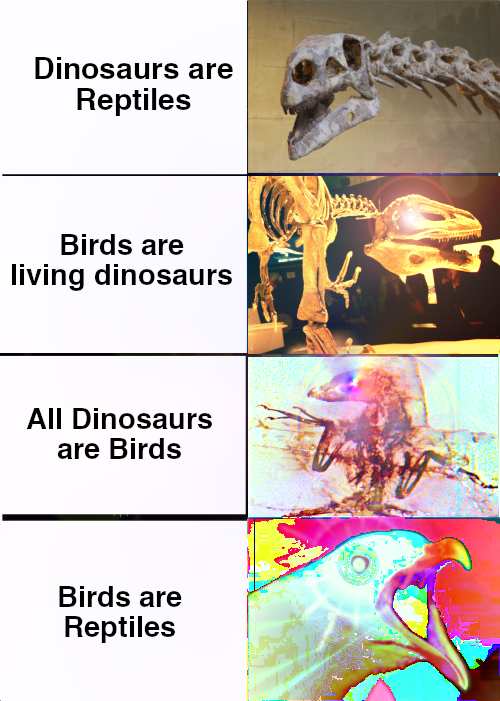
CLADISTICS ruined my life
#return to monke more like return to woerm#biology#science#zoology#could go into the arthropod world or even the fish world but thats a whole other can of worms haha#crab is not inevitable#its just. convergent evolution. that's it. beneficial traits for a niche#but im just a lowly zoologist so what do i know#not like speculative evolution/zoology is my favorite thing#not like i havent waded thru lectures and journal papers n specimen collections where each group bashed on each other#that meme where it's 'ive had enough of this guy' but its carcinization. this is a hill i will die on
114K notes
·
View notes
Text
Why ‘Vampire Deer’ Have Fangs, While Other Hoofed Mammals Have Horns
(Inside Science) — When do you need a broadsword, and when would you be better off with a dagger? That’s the question that faced artiodactyls, the group of mammals that includes deer, antelope, goats, giraffes, pigs, buffalo and cows, during their evolution.
Many male artiodactyls fight over females using weaponized body parts such as horns and antlers. But pigs and several groups of deerlike animals have tusks instead, and a few species have both. Water deer have tusks so pronounced they are nicknamed “vampire deer.” To understand this variation, researchers compared the habitats and behavior of 63 species, including members of every living artiodactyl group except hippos and whales. They also measured the canine teeth of each species using skeletal specimens in museums.
The species in which males’ canines were enlarged into tusks were much more likely to be small-bodied and to live solitary lifestyles. And while no direct statistical relationship was found between tusks and habitat, the small, solitary species were more likely to live in dense foliage. For example, the rabbit-sized Java mouse deer has tusks more than half an inch long, and it lives in undergrowth so dense that it makes tunnels as it moves from place to place.
This makes sense, say the researchers, because daggerlike tusks are likely to be the most effective weapons in thick underbrush. In open habitats, there is more room to swing more elaborate horns and antlers without getting tangled. Moreover, the mere sight of these weapons is often enough to intimidate another male into backing down.
Such signals would be less useful in dense brush. “There’s no point in signaling, ‘Hey, I’m big and strong,’ because you’re already up close with this opponent. So, it makes more sense to prepare for a direct fight and have a slicing, stabbing-type weapon that can inflict more damage,” said Ted Stankowich, an evolutionary biologist at California State University, Long Beach, who conducted the study with then undergraduate student Doreen Cabrera. They published the findings Nov. 9 in the Journal of Mammalian Evolution.
In this article, Nala Rogers discusses the anatomy of artiodactyls, a groups of animals that have an even number of toes on their hooves. Many males of the order Artiodactyla have specific anatomical characteristics that allow them to fight each other for females. Some species have antlers or horns, while others have tusks, and some species even have both, such as the water deer. They are nicknamed “vampire deer” for their large canine-like tusks. To study why the variation exists, a team of researchers studied the behavioural and habitional differences between 63 species of artiodactyls. They discovered that the species with tusks were more likely to be small, and live alone in vegetation. The horned or antlered animals were often in open areas that allow them to swing their appendages and fight without fear of being caught in branches or bushes. Antlers also serve as a warning to other animals in the area, and would be easily visible in an open area. However, in a forest, the antlers would be difficult to see among similarly shaped things and would serve no purpose. In that case, a pair of tusks would be more suited.
Evolution is the process of biological change over time based on the relationships between species and their environments.
This article shows the animals that have adapted to suit their needs in the environment that they inhabit. Despite belonging to the same order, the Artiodactyls have all developed in different ways, allowing them to survive the challenges in the environment.
Reference
Why 'Vampire Deer' Have Fangs, While Other Hoofed Mammals Have Horns. (2018, November 15). Retrieved January 6, 2019, from http://blogs.discovermagazine.com/d-brief/2018/11/15/isns-why-vampire-deer-have-fangs-teeth-while-other-hoofed-mammals-have-horns/
1 note
·
View note
Text
the problem with this website is that people don't know the difference between artiodactyls (even-toed hoofed mammals, include cows, sheep, antelope, giraffes, camels, pigs, cetaceans, hippos, and deer) and perissodactyls (odd-toed hoofed mammals, includes horses, rhinos, and tapirs)
43 notes
·
View notes
Text
Meat-eating mammals are more susceptible to cancer than herbivores
Mammals that live on meat are more likely to die of cancer than those that only eat plants, according to a study of tens of thousands of zoo animals from around the world.
Orsolya Vincze at the Centre for Ecological Research in Hungary and her colleagues analysed post-mortem records for 110,148 animals from 191 mammal species that died in zoos to determine their risk of dying from cancer.
They found that carnivorous mammals were much more likely to die of cancer than mammals that rarely or never eat animals. The artiodactyls, a mostly herbivorous group that includes antelopes, sheep and cows, was the least cancer-prone order of mammals.
The most cancer-prone species was the kowari (Dasyuroides byrnei), a small, carnivorous, Australian marsupial, with 16 of the 28 post-mortem records available for the species stating cancer as the cause of death.
In contrast, none of the 196 blackbucks (Antilope cervicapra) or the 213 Patagonian maras (Dolichotis patagonum) were recorded as having cancer when they died. Blackbucks are grass-eating antelopes native to India and the Patagonian mara is a large, grass-eating rodent found in Argentina.
The findings challenge the common belief that bigger animals with longer lifespans are most at risk of getting cancer, since they have more cells that can mutate and there is more time for mutations to occur. Instead, cancer risk appears to be heavily influenced by diet, although more research is needed to confirm whether the relationship seen in captive mammals is also found in wild populations, say the researchers.
One reason why carnivores may be more prone to cancer is that raw meat can contain viruses that have the potential to cause cancer when ingested, says Vincze. For example, cancers in some captive lions have been found to be related to papillomavirus in cow carcasses they ate, she says.
Another reason may be that carnivores are more exposed to pollutants that become increasingly concentrated in animals further up the food chain, says Beata Ujvari at Deakin University in Geelong, Australia, who was also involved in the study. Moreover, carnivores have high-fat, low-fibre diets and less diverse gut bacteria than plant-eaters, which are factors that have been associated with cancer risk in people, she says.
The finding that meat-eating mammals are more susceptible to cancer doesn’t necessarily mean that people who eat meat are also more at risk, since we have different lifestyles to other mammals and don’t tend to eat raw meat, says Ujvari. However, some human studies have linked meat consumption with increased cancer risk, she says.
At this stage, it is unclear why artiodactyls seem to be unusually resistant to cancer, but a better understanding of this could help protect us from cancer too, says Ujvari. Their low-fat, fibre-rich plant diet may be a factor, or they may have evolved natural anti-cancer defences to compensate for the extra cancer potential caused by their large size, she says.
Species like the blackbuck and the Patagonian mara are of particular interest due to their exceptionally low cancer mortality rates, says Vincze. “Understanding how they defy cancer may help us to develop cancer treatments.”
https://targetnews.buzzious.com
0 notes
Text
WORD OF THE DAY ~ Flehmen
WORD OF THE DAY ~ Flehmen
Welcome to Vocabulary Wednesday ~Words To Help You Write Better FlehmenNouna curling of the upper lip and raising of the head in certain mammals in response to olfactory stimuli, which behaviour allows the scents better to reach an olfactory organ deep within the animal’s nosea behavioral response of many male mammals, esp. deer, antelope, and other artiodactyls, consisting of lip curling and…

View On WordPress
0 notes